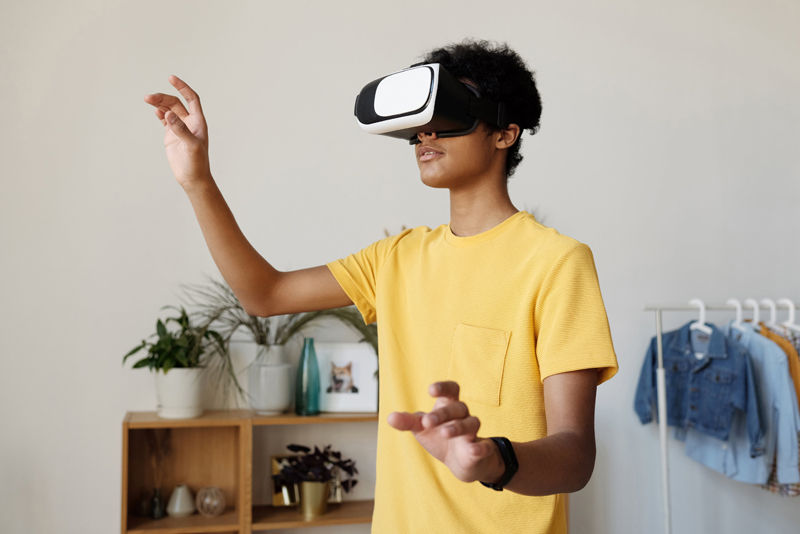Mastering The Metaverse: Elevating Consumer Experience and Engagement Strategies
A game-changer for businesses, the metaverse is a gateway to immersive experiences that redefine customer engagement through personalised journeys, innovative product experiences, and unforgettable brand activations.
The metaverse stands as a monumental leap beyond the confines of the traditional internet experience. Gone are the days of passive observation; the metaverse immerses users in an expansive digital landscape that mirrors the intricacies of the physical world.
At its core, the term "metaverse" encapsulates a spectrum from virtual reality (VR) to augmented reality (AR) technologies, seamlessly integrating with consumers' lives and fundamentally reshaping how people interact with the digital realm. Despite the existing challenges, the continuous advancements in technology, spanning from cutting-edge VR headsets to innovative AR glasses, are laying the foundation for a more immersive and interconnected existence.
As we move ahead, and these AR/VR devices become potentially more affordable and accessible, they will act as a bridge linking our physical and digital realities. They will enable us not only to socialise, work, and play but to thrive within extraordinary virtual landscapes. Companies such as Meta and Microsoft are at the forefront of this revolution, investing in technologies that promise more than just novel gaming experiences. They herald a transformation in how we connect, learn, and create. In its idealised form, the metaverse holds the power to democratise experiences, fostering collaboration, exploration, and unprecedented flourishing among individuals from diverse backgrounds.
Looking ahead to 2026, a significant shift is anticipated: a quarter of the global population is expected to spend an hour daily in the metaverse, engaging in a myriad of activities. This surge in metaverse adoption is mirrored by the staggering rise in global shipments of augmented reality (AR) and virtual reality (VR) devices. Predicted to escalate from 14 million units in 2022 to a remarkable 88 million units by 2026, this sixfold increase marks a transformative period in technological evolution.
Today's consumers actively seek metaverse experiences that enhance their real-world interactions, even if it means investing financially. These experiences encompass a spectrum of applications, ranging from digital fittings for apparel and shoes to engaging group fitness classes and interactive cooking sessions. Notably, ByondXR, an AR/VR provider, reports an astounding 400% surge in customer engagement through their immersive shopping experiences tailored specifically for its retail clients.
Going beyond the limitations of traditional shopping avenues, whether physical stores, online platforms, or mobile apps, the metaverse empowers retailers to engage consumers in ways previously deemed unattainable.
Embracing these groundbreaking innovations empowers businesses to redefine interactions and cultivate unparalleled brand-consumer relationships. The metaverse isn't merely a concept; it's a dynamic reality reshaping the way we connect, learn, and engage, heralding a future where the possibilities are boundless.
Discovering Products in a New Light
The metaverse enables immersive product exploration, transcending traditional online limitations. By engaging in these immersive experiences, customers gain the ability to do things they might not have been able to in the physical world, or do things in a unique and innovative way.
Companies such as Mahindra and Maruti are amongst the few carmakers to leverage the metaverse. Mahindra recently introduced its Metaverse platform for virtual experiences and test drives of the XUV400 electric SUV. Similarly, Maruti's ArenaVerse embodies their digital shift. Maruti streamlined 24 of 26 car buying steps in 2021.
Within the online multiplayer game Roblox, Gucci and Nike have launched fashion shows. Balenciaga now provides high-end clothing in Fortnite. Zepeto, a South Korean social avatar app, along with Ralph Lauren and Adidas, offers interactive experiences.
Farzi Café in the Metaverse offers virtual and physical culinary experiences. Users play games to collect ingredients, mint tokens, and redeem them at real restaurants nationwide.
These examples illustrate how the metaverse transcends traditional limitations, offering consumers unique and engaging ways to interact with products and brands.
Fusing the Physical and Virtual Realms
The metaverse integrates physical and digital goods seamlessly, offering consumers unique, limited-edition products. Prior to the FIFA World Cup Qatar 2022., FIFA collaborated with Visa for a unique NFT auction, allowing fans to buy digital art inspired by iconic football goals.
Innovations like Coca-Cola's digital drops and digital twins, replicating real-world objects, offer consumers engaging experiences, blurring the lines between physical and virtual reality.
Fenty and Byredo are empowering customers to create products in the metaverse. Customers gather virtual ingredients for Fenty's beauty gloss bomb on Roblox and Byredo's "aura" NFT perfume in Rtfkt. Rihanna's chosen Roblox formula for Fenty will become a physical product in 2024. Byredo's metaverse-created perfumes are verified via their original digital twins when they become physical products.
This fusion creates exclusive, limited-edition items that bridge the gap between the tangible and digital worlds.
Intelligent Connections through Digital Humans
The advent of intelligent connections facilitated by digital humans showcases an extraordinary blend of artificial intelligence and human ingenuity. Fuelled by state-of-the-art AI algorithms, digital entities are revolutionising our modes of communication, education, and entertainment. They represent a pivotal leap, breaking barriers that once separated the realms of artificial and human intelligence. With their seamless integration into our lives, they're not just transforming interactions but fundamentally altering how we perceive the boundaries between the virtual and real worlds.
AI-powered avatars, or "digital humans," are reshaping customer interactions. For instance, Odisha TV recently launched an AI-generated news anchor named 'Lisa'. Punjabi singing icon Daler Mehndi attracted 20 million viewers worldwide, marking India's first metaverse concert a massive success. At Sphere, Las Vegas, five Aura humanoid robots serve as a guide to visitors.
Why Metaverse?
In the early 2010s, businesses did not fully utilise digital tools like email, social media, and SMS. Some forward-thinking ones adopted omnichannel methods, but as digital platforms grew, consumers expected seamless brand experiences online. This demand led to the development of new technologies for managing customer relationships, cloud services, APIs, and ensuring compatibility between various tech systems. Successful companies combined digital convenience with skilled service representatives' problem-solving abilities and empathy, ensuring high engagement and service quality.
The metaverse represents the next evolution, where consumer experiences should enhance existing interactions, creating a new way of engaging with customers. However, omnichannel retail faces challenges. Coherently integrating customer data for analysis is problematic, affecting personalisation and causing trust issues due to inconsistent information across channels. Moreover, inefficiencies in supply chain management and difficulties in integrating physical and digital experiences hamper omnichannel retail. These issues underline the urgent need for streamlined data integration, improved transparency, and seamless blending of physical and digital retail interactions.
Vandith Pamuru, Assistant Professor, Information Systems, ISB, says “In the dynamic landscape of the metaverse, businesses face an unprecedented opportunity to redefine consumer engagement. By delving into immersive experiences like virtual car test drives and interactive culinary adventures, companies can create deeply personalised encounters, elevating brand-consumer relationships to new heights. Leaders must adopt a nuanced approach: They must map customer needs, seamlessly integrate metaverse strategies, and proactively solve consumer pain-points.”
What can Business Leaders do?
Transitioning from a 2D to 3D technology-driven world brings with it an exponential increase in data volumes, propelling data-driven marketing into the forefront of strategic considerations. To effectively navigate this evolving landscape, businesses are recognising the importance of expertise in data analysis and real-time strategies.
In this digital paradigm shift, the metaverse emerges as a promising frontier. By leveraging data analytics within the metaverse, businesses can gain profound insights into consumer behaviour. These insights are transformative, serving as the foundation for refining marketing strategies and product designs across both virtual and physical realms.
However, for CXOs contemplating entry into the metaverse, a cautious approach is vital. It is unwise for organisations to plunge headlong into substantial investments without careful consideration of their strategies. To make this transition effectively, leaders must adopt a nuanced approach:
- Adopt an "Outside-In" Approach: Leaders must adopt an empathetic stance, focusing on understanding their target customers' experiences within the metaverse. This entails analysing existing customer research through the lens of metaverse opportunities. By delving deep into customer behaviour and preferences, leaders gain invaluable insights. This understanding allows for the tailoring of metaverse strategies, aligning them precisely with customer needs. By embracing this 'outside-in' perspective, businesses can create metaverse experiences that genuinely resonate with their audience, establishing a strong rapport and lasting engagement.
- Integrate Metaverse Strategies with Existing Frameworks: To ensure a seamless transition into the metaverse realm, leaders must align their metaverse strategies with overarching enterprise frameworks. This integration should span across corporate, marketing, and customer experience strategies. By harmonising metaverse initiatives with existing business goals, leaders avoid disruptions and instead enhance their current practices. The metaverse becomes a natural extension of their brand, fostering cohesion and consistency across various customer engagement channels. This strategic alignment not only streamlines operations but also amplifies the impact of metaverse ventures, creating a unified and compelling brand presence.
- Identify and Address Pain Points with Metaverse: Leaders should meticulously evaluate existing customer journeys, identifying pain points that immersive technology in the metaverse can address. By leveraging the capabilities of the metaverse, leaders can enhance customer experiences and offer innovative solutions that add tangible value. It is imperative to focus on problem-solving and creating positive interactions. By doing so, metaverse initiatives align seamlessly with customer expectations and business objectives and positions the business as a proactive problem solver in the metaverse landscape.
The metaverse offers unparalleled opportunities for businesses to redefine consumer experiences, providing fresh insights and adventures. By embracing the metaverse's potential, marketers, product developers, and planners can create immersive, personalised encounters, driving a new era of brand-consumer relationships across various industries. It is imperative for businesses to dive into the metaverse now, shaping the future of customer engagement.
References
-
Deloitte (2022). The future of retail: Customer experience in the Metaverse
https://www2.deloitte.com/us/en/pages/consulting/articles/future-of-retail-customer-experience-in-the-metaverse.html -
CCS Insight (2022). Economic uncertainty dampens short-term VR and AR outlook
https://www.ccsinsight.com/blog/economic-uncertainty-dampens-short-term-vr-and-ar-outlook/ -
Gartner (2022). Gartner Predicts 25% of People Will Spend At Least One Hour Per Day in the Metaverse by 2026
https://www.gartner.com/en/newsroom/press-releases/2022-02-07-gartner-predicts-25-percent-of-people-will-spend-at-least-one-hour-per-day-in-the-metaverse-by-2026#:~:text=By%202026%2C%2025%25%20of%20people,research%20vice%20president%20at%20Gartner -
McKinsey & Co. (2023). Unlocking Commerce in Metaverse
https://www.mckinsey.com/capabilities/growth-marketing-and-sales/our-insights/unlocking-commerce-in-the-metaverse -
Vogue Business (2023). Demand for customisation boosts Hourglass and Tatcha
https://www.voguebusiness.com/beauty/demand-for-customisation-boosts-hourglass-and-tatcha-vogue-business-beauty-index





